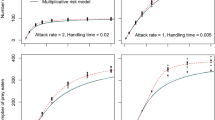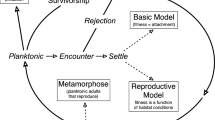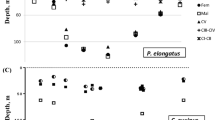Abstract
Current behaviour-based interference models assume that the predator population is infinitely large and that interference is weak. While the realism of the first assumption is questionable, the second assumption conflicts with the purpose of interference models. Here, we tested a recently developed stochastic version of the Beddington–DeAngelis functional response—which applies to a finite predator population without assuming weak interference—against experimental data of shore crabs (Carcinus maenas) foraging on mussels (Mytilus edulis). We present an approximate maximum likelihood procedure for parameter estimation when only one focal individual is observed, and introduce ‘correction factors’ that capture the average behaviour of the competing but unobserved individuals. We used the method to estimate shore crab handling time, interaction time, and searching rates for prey and competitor. Especially the searching rates were sensitive to variation in prey and competitor density. Incorporating constant parameter values in the model and comparing observed and predicted feeding rates revealed that the predictive power of the model is high. Our stochastic version of the Beddington–DeAngelis model better reflects reality than current interference models and is also amenable for modelling effects of interference on predator distributions.





Similar content being viewed by others
References
Abrams PA (1990) The effects of adaptive behavior of the type-2 functional response. Ecology 71:877–885
Beddington JR (1975) Mutual interference between parasites and predators and its effect on searching efficiency. J Anim Ecol 44:331–340
Begon M, Harper JL, Townsend CR (1990) Ecology: individuals, populations, and communities. Blackwell Scientific Publications, Oxford
Billingsley P (1961) Statistical methods in Markov chains. Ann Math Stat 32:12–40
Brockmann HJ, Barnard CJ (1979) Kleptoparasitism in birds. Anim Behav 27:487–514
Broom M, Ruxton GD (1998) Evolutionarily stable stealing: game theory applied to kleptoparasitism. Behav Ecol 9:397–403
Cresswell W (1998) Variation in the strength of interference competition with resource density in blackbirds, Turdus merula. Oikos 81:152–160
Crothers JH (1968) The biology of the shore crab Carcinus maenas (L.) 2. The life of the adult crab. Field Stud 2:579–614
DeAngelis DL, Goldstein RA, O’Neill RV (1975) A model for trophic interaction. Ecology 56:881–892
Dolman PM (1995) The intensity of interference varies with resource density: evidence from a field study with snow buntings, Plectrophenox nivalis. Oecologia 102:511–514
Donazar JA, Travaini A, Ceballos O, Rodriguez A, Delibes M, Hiraldo F (1999) Effects of sex-associated competitive asymmetries on foraging group structure and despotic distribution in Andean condors. Behav Ecol Sociobiol 45:55–65
Érdi P, Tóth J (1988) Mathematical models of chemical reactions: theory and applications of deterministic and stochastic models. Princeton University Press, Princeton
Finelli CM, Pentcheff ND, Zimmer RK, Wethey DS (2000) Physical constraints on ecological processes: a field test of odor-mediated foraging. Ecology 81:784–797
Fretwell SD, Lucas HL (1970) On territorial behaviour and other factors influencing habitat distribution in birds. Acta Biotheor 19:16–36
Goss-Custard JD (1980) Competition for food and interference amongst waders. Ardea 68:31–52
Goss-Custard JD, Sutherland WJ (1997) Individual behaviour, populations and conservation. In: Krebs JR, Davies NB (eds) Behavioural Ecology: an evolutionary approach, 4th edn. Blackwell Scientific Publications, Oxford, pp 373–395
Haccou P, Dienske H, Meelis E (1983) Analysis of time-inhomogeneity in Markov chains applied to mother–infant interactions of rhesus monkeys. Anim Behav 31:927–945
Holling CS (1959) Some characteristics of simple types of predation and parasitism. Can Entomol 91:385–398
Holmgren N (1995) The ideal free distribution of unequal competitors: predictions from a behaviour-based functional response. J Anim Ecol 64:197–212
Jeschke JM, Kopp M, Tollrian R (2002) Predator functional responses: discriminating between handling and digesting prey. Ecol Monogr 72:95–112
Metz JAJ, Dienske H, de Jonge G, Putters FA (1983) Continuous time Markov chains as models for animal behaviour. Bull Math Biol 45:643–658
Moody AL, Houston AI (1995) Interference and the ideal free distribution. Anim Behav 49:1065–1072
Norris J (1997) Markov chains. Cambridge University Press, Cambridge
Norris K, Johnstone I (1998) Interference competition and the functional response of oystercatchers searching for cockles by touch. Anim Behav 56:639–650
Parker GA, Sutherland WJ (1986) Ideal free distribution when individuals differ in competitive ability: phenotype-limited ideal free models. Anim Behav 34:1222–1242
Ross SM (1989) Introduction to probability models. Academic Press, San Diego
Ruxton GD, Moody AL (1997) The ideal free distribution with kleptoparasitism. J Theor Biol 186:449–458
Ruxton GD, Gurney WSC, De Roos AM (1992) Interference and generation cycles. Theor Popul Biol 42:235–253
Sih A (1980) Optimal behavior: can foragers balance two conflicting demands? Science 210:1041–1043
Smallegange IM, Van der Meer J (2007) Interference from a game theoretical perspective: shore crabs suffer most from equal competitors. Behav Ecol 18:215–221
Smallegange IM, Van der Meer J (2009) The distribution of unequal predators across food patches is not necessarily (semi)-truncated. Behav Ecol 20:525–534
Smallegange IM, Van der Meer J, Kurvers RHJM (2006) Disentangling interference competition from exploitative competition in a crab-bivalve system using a novel experimental approach. Oikos 113:157–167
Sneddon LU, Huntingford FA, Taylor AC (1997) Weapon size versus body size as a predictor of winning in fights between shore crabs, Carcinus maenas (L.). Behav Ecol Sociobiol 41:237–242
Stillman RA, Goss-Custard JD, Caldow RWG (1997) Modelling interference from basic foraging behaviour. J Anim Ecol 66:692–703
Stillman RA, Poole AE, Goss-Custard JD, Caldow RWG, Yates MG, Triplet P (2002) Predicting the strength of interference more quickly using behaviour-based models. J Anim Ecol 71:532–541
Sutherland WJ, Dolman PM (1994) Combining behaviour and population dynamics with applications for predicting the consequences of habitat loss. Philos Trans R Soc Lond B Biol Sci 255:133–138
Sutherland WJ, Parker GA (1985) Distribution of unequal competitors. In: Sibly RM, Smith RH (eds) Behavioural ecology—ecological consequences of adaptive behaviour. Blackwell Scientific Publications, Oxford, pp 255–273
Taylor DL, Collie JS (2003) Effect of temperature on the functional response and foraging behavior of the sand shrimp Crangon septemspinosa preying on juvenile winter flounder Pseudopleuronectes americanus. Mar Ecol Prog Ser 263:217–234
Vahl WK, Van der Meer J, Weissing FJ, Van Dullemen D, Piersma T (2005) The mechanisms of interference competition: two experiments on foraging waders. Behav Ecol 16:845–855
Van der Meer J, Ens BJ (1997) Models of interference and their consequences for the spatial distribution of ideal and free predators. J Anim Ecol 66:846–858
Van der Meer J, Smallegange IM (2009) A stochastic version of the Beddington–DeAngelis functional response: modelling interference for a finite number of predators. J Anim Ecol 78:134–142
Warner GF (1977) The biology of crabs. Paul Elek (Scientific Books) Ltd, London
Yates GE, Broom M (2007) Stochastic models of kleptoparasitism. J Theor Biol 248:480–489
Acknowledgments
We would like to thank Maurice Sabelis for constructive comments and discussion. IMS was financially supported by a research grant from the Netherlands Organization for Scientific Research (NWO).
Author information
Authors and Affiliations
Corresponding author
Additional information
Communicated by F. Bulleri.
Appendix: Markov chains of the foraging process
Appendix: Markov chains of the foraging process
-
1.
States and transition rates
The transition matrix of the focal-predator Markov chain of one predator consists of the behavioural states S and H with associated transition rates νD and λ (Table 4). The states and transition rates in the transition matrix of the two and three predator Markov chain are shown in such a way that the behaviour of the focal predator and that of the other predators is easily interpreted (Tables 4, 5): the four states are lumped according to the state of the focal predator: (S) focal predator is searching, (H) focal predator is handling, (F) focal predator is fighting after searching, and (G) focal predator is fighting after handling.
-
2.
Limiting probabilities
The probability that a continuous-time Markov chain will be in state j at time t converges under certain conditions to a limiting value, or limiting probability, independent of the initial state (Ross 1989, pp. 268–275). These conditions hold for models of the kind considered here. The limiting probability of each state is then the time that the Markov chain, or the foraging process of the predators, is in that state. For each Markov chain, the limiting probabilities were derived relative to the limiting probability for the ‘all searching’ state. They are referred to as relative limiting probabilities and are given in Tables 4 and 5.
-
3.
Rationale behind maximum likelihood estimators when only the focal predator is observed
From the Markov chains for two and three predators, it appears that the transitions from S to H (rate νD), from H to S (rate λ), from F to S (rate φ) and from G to S (rate φ) have a constant transition rate, independent of the behaviour of the other predators. The only problem concerns the transitions from S to F and from H to G, which do depend upon the states of the other(s). To cope with this problem, we have assumed that the states of the others are in equilibrium and are thus proportional to the limiting probabilities. Using this approximation (where necessary), the maximum likelihood approach, as described by Van der Meer and Smallegange (2009) can be used to estimate the parameters ν, μ, λ, and φ, and their maximum likelihood estimators are given in the main text. In the log-likelihood function, the correction factors p and q were introduced, because, if only the behaviour of a focal predator is observed, they are needed in order to arrive at transition rates under the assumption of average behaviour of the other predators in the system. Table 6 can be used to derive the correction factors p and q. For two predators, the state of the non-focal predator does not matter for the transition from the focal predator state S to the focal-predator state F. Whatever the other is doing (searching or handling), the two predators will start a fight when they encounter each other (which happens with a rate equal to μ). The factor p therefore equals 1 (Table 6). When the focal predator is handling the ratio of the time that the other predator is searching equals 1/(1 + α), where α is νD/λ. Only in that case, will the two predators start a fight. Hence, q equals 1/(1 + α). Similarly, it can be derived from Table 6 (summing the products of the number of possible fights times the relative limiting probability and dividing that sum by the sum of the relative limiting probabilities) that for three predators
and for four predators
These correction factors require knowledge of α and of β = μ/φ, and thus of μ itself. Henceforth, an iterative procedure has to be used to estimate μ. Starting with a guestimate of μ, and thus of p and q, an estimate of the parameter μ is obtained by using Eq. 5. This estimate is then used to obtain new values for p and q, which in turn are used for a new estimate of μ. This procedure is repeated until convergence is obtained. Data from separate trials can be lumped in the parameter estimation procedure.
-
4.
Simulating the foraging behaviour
For the focal-predator Markov chain of two predators six stochastic reactions—the transitions between states (cf. Table 4)—can be specified. For the focal-predator Markov chain of four predators, we specified the stochastic reactions of one individual of the predator population and lumped the stochastic reactions of the remainder of the predator population. The order and timing of the stochastic reactions proceeds as follows (Ross 1989). Each reaction has an associated rate, or hazard, and at a given point in time all hazards are calculated and summed to give the total event hazard R. The time to the next event is drawn from an exponential distribution with mean 1/R. One out of all possible reactions is then selected to occur at the next time-point, and each reaction has a probability of being selected equal to its associated hazard divided by the total event hazard R. The simulation then proceeds to the next time-point. This procedure is repeated until a pre-defined final time or event is reached.
We simulated each experiment by mimicking the ‘experimental procedure’, of the two experiments in Smallegange et al. (2006). In the experiments, prior to each trial, crabs were allowed to acclimatize to the tank for an arbitrarily chosen time period of 10 min. In each trial, the foraging behaviour of one focal crab was scored. The first experiment was concerned with the time period in which the focal crab searched for and ate a single mussel. The second experiment was concerned with two consecutive time periods in which the focal crab searched for and ate a mussel. In the simulations, all individuals started in the searching state. After a ‘start-up period’ of 10 min, the ‘observation’ started after the focal individual had consumed the first prey item. For comparison with the first experiment, the ‘observation period’ ended when the focal individual had consumed the second prey item, and for comparison with the second experiment, the ‘observation period’ ended when the focal individual had consumed the third prey item.
-
5.
Calculating y 3 + y 4 from the relative limiting probabilities
The expected time that an individual spends fighting, i.e. interfering, while capturing one prey item (y 3 + y 4), is calculated using the relative limiting probabilities of the Markov chains. That is, from the relative limiting probabilities we first express the proportion of time an individual interferes per unit handling time by summing the relative limiting probabilities of the states in which the focal crab is in the behavioural state F or G, \( I^{*} \), and dividing this over the sum of all relative limiting probabilities, \( P_{{}}^{*} \).
The proportion of time that a predator handles a prey item, \( H_{{}}^{*} /P_{{}}^{*} \), is likewise derived, and dividing \( I_{{}}^{*} /P_{{}}^{*} \)over \( H_{{}}^{*} /P_{{}}^{*} \)gives the proportion of time an individual interferes per unit handling time. For a predator foraging with one competitor this equals:
and for a predator foraging with three competitors this equals:
(relative limiting probabilities for the Markov chain of four predators can be found in Van der Meer and Smallegange 2009). Multiplying each equation with the (constant) estimated handling time for one prey item (1/λ) results in the expected absolute time that a predator interferes while capturing one prey item (\( E[y_{3} + y_{4} ] \)).
Rights and permissions
About this article
Cite this article
Smallegange, I.M., van der Meer, J. Testing a stochastic version of the Beddington–DeAngelis functional response in foraging shore crabs. Mar Biol 157, 1027–1040 (2010). https://doi.org/10.1007/s00227-009-1382-z
Received:
Accepted:
Published:
Issue Date:
DOI: https://doi.org/10.1007/s00227-009-1382-z




